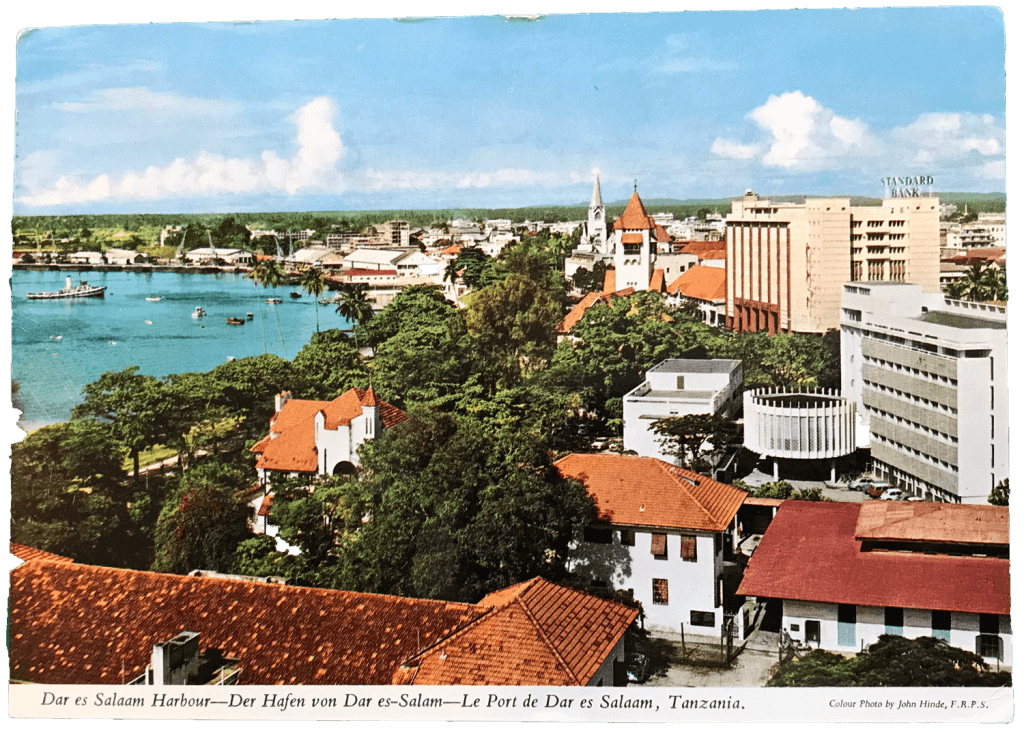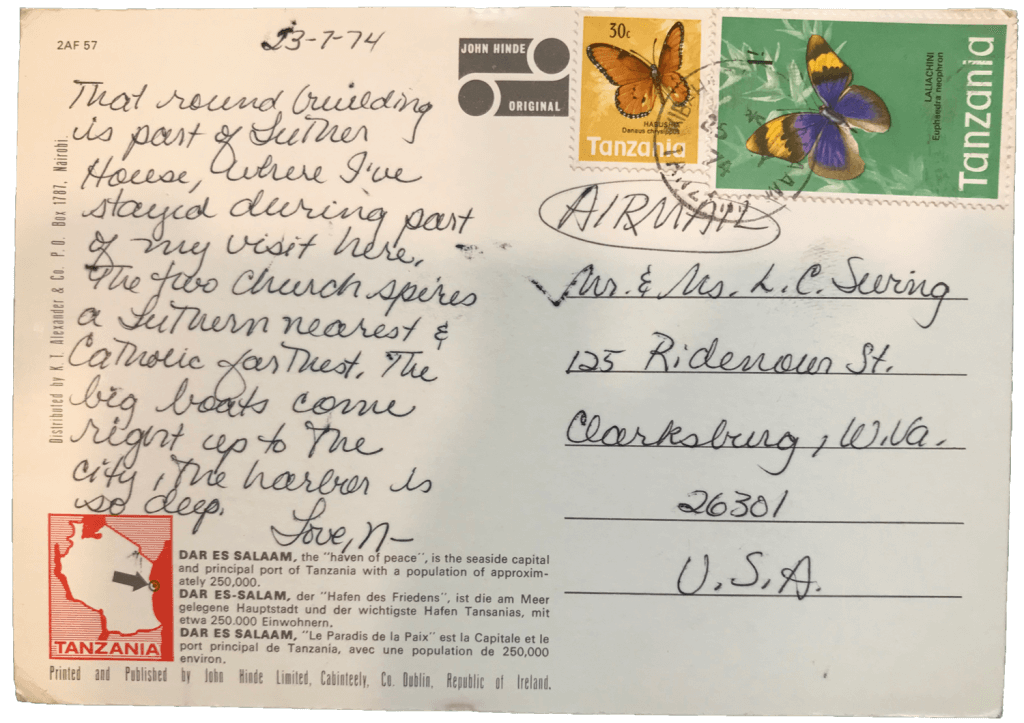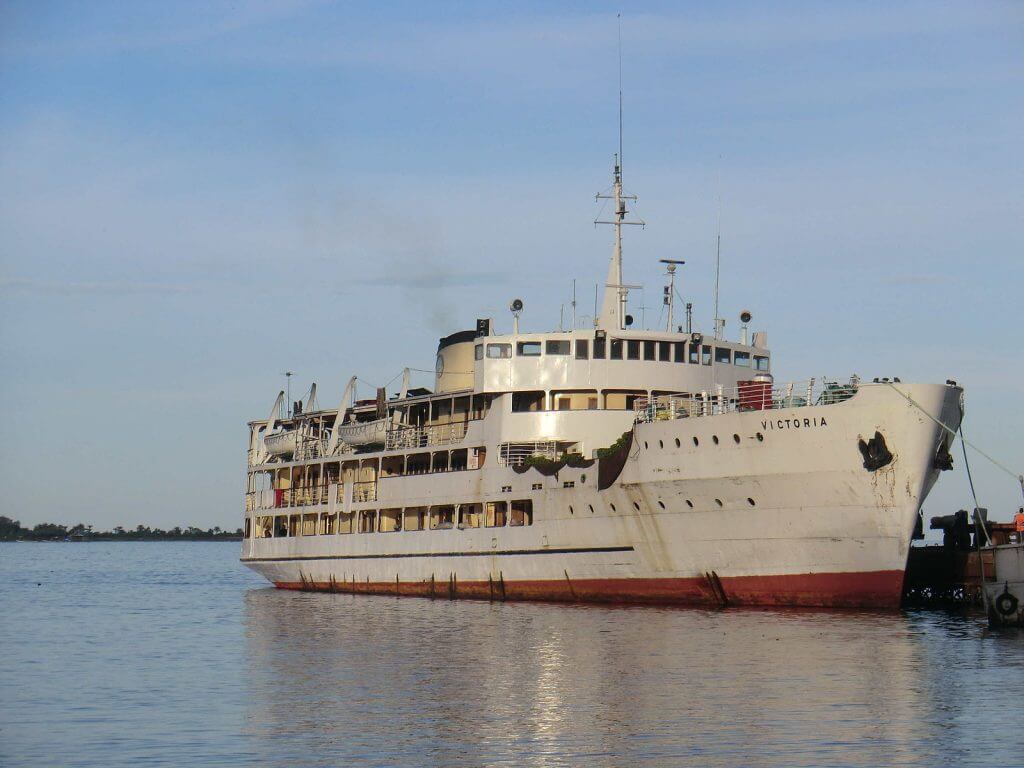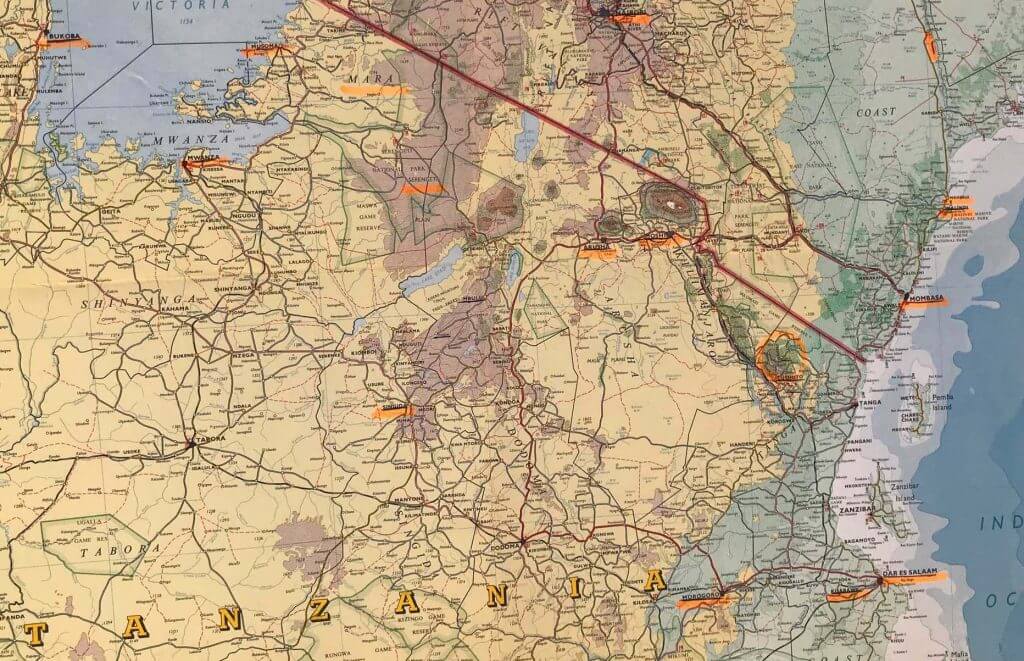#4: Starting the ELCT Film, 1974-75
Let me turn, in this post, from our domestic to my professional life in East Africa. My participation in the Evangelical Lutheran Church in Tanzania film project entailed a lot of red tape with both ELCT and the Tanzanian government. One example of the latter was that any entity hiring a foreign national had to certify there was no Tanzanian qualified for the job. Without that, the foreigner wouldn’t be granted the necessary work permit. Before that challenge could be hurdled, ELCT’s Executive Committee had to approve the project and the script, plus find funding for my services. Then we had all sorts of travel glitches, as revealed in my letters home.
1974
April 23 Arusha
The Lutherans have asked me to write the script for the film I told you about in early February. I have my first meeting with them tomorrow.
April 29 Arusha
I’ll write the script, which entails traveling all over Tanzania and southern Kenya. I don’t know yet if I’ll be helping with the filming or not — one step at a time. I sure feel better knowing I have some work to do.
May 6 Arusha
I’m in the research phase, reading books by/about missionaries plus files and reports to get ideas for content. Later, we’ll visit ELCT’s hospitals, sanitariums, leprosariums, schools and seminaries, traveling to places that most foreigners don’t get to see. Russ is as pleased as I am about all this.
May 15 Arusha
My work on the film is going very well. I’m in the last stages of completing the “treatment,” sort of an outline written before the script so everyone can agree on general scope and technique. The Executive Council meets later this month. If they approve the treatment, I’ll start traveling to potential film locations in order to research specifics.
May 24 Arusha
My treatment was accepted by the Executive Secretary of the Church. He’s submitting it to the Executive Council for approval with very few changes.
June 3 Arusha
The film received additional funding from the Executive Council last week, so we should get started pretty soon on 3- to 7-day safaris. I’m meeting with my Tanzanian colleague, Mr. T, later today to discuss details. He has good skills as a cameraman and film-processor, I’m told, but not as a writer-producer.
June 17 Arusha
I’ve ordered a pair of handmade safari boots ($10.50), so I feel like my film trips are nearly underway. We agreed the other day on salary plus traveling expenses.
June 19 Arusha
I was supposed to go to Dar es Salaam [the capital of Tanzania, on the coast] today and back on Friday for the film, but we had to alter our plans because the people we wanted to see wouldn’t be there.
July 9 Arusha
I’m going to Dar on the 20th for ELCT’s biennial Assembly. The entire Assembly will adjourn the next day to travel to Morogoro, west of Dar, where there’ll be a cornerstone-laying ceremony. Then we’ll be back in Dar through the 25th. The 26th, the film crew will go to the Usambara Mountains, northwest of Dar, called the “Switzerland of Tanzania” for the Consecration of the first African bishop in ELCT. Because these are one-of-a-kind events, we’ll film both live and later write the script to fit.
July 23 Near Dar es Salaam
I’m at the Kibaha Educational Centre outside Dar. Built by the Nordic countries, it’s practically a whole town in itself with a secondary school, agricultural school, hospital, nursing school, stores and post office. This is where ELCT is having its General Assembly.
I flew down Saturday via Mombasa, staying two nights in Dar. Altho I didn’t get to see much, I had some great seafood.
Sunday we drove to Morogoro, where we filmed the ceremony laying the cornerstone for the Junior Seminary (where young people are trained for church work at the secondary school level). Lots of music, including a brass band and 4 choirs who came from all over Tanzania, singing in traditional African style and often dancing.
The road to Morogoro is part of the Tan-Zam Highway connecting Zambia with the coast and built by the Americans. Its two-lane blacktop is a great improvement over the short stretch of old road we traveled on.
The meetings are conducted in rapid Swahili, so much is lost to me. I only need the broad concepts, so this is not a major handicap, at least not now.
August 1 Arusha
I so enjoyed Dar es Salaam. We had a free day on Friday, and I walked along the harbor, past many beautiful public buildings, through the botanical gardens and toured the museums.


The whole trip was most interesting, especially the two days I spent in the Usambaras, where we filmed the Consecration of a bishop. The mountains are very beautiful, rising to 5,000 feet. All roads are dirt and narrow, with spectacular scenery often reminding me of West Virginia.
***
I wrote extensively in a journal about the deeply moving ceremony to consecrate the first African bishop in ELCT. That journal seems to be in storage, still inaccessible thanks to the pandemic shelter-in-place, so I’ll try to relate one of the most momentous experiences of my professional life from memories still vivid 45 years later.
I remember rising early in the morning, being collected, along with Mr. T and all our gear, and driven to an outdoor platform set up in a natural bowl surrounded by high hills. Already at that hour, villagers were streaming in, dressed in their best, brightly colored African prints, filling the hillsides all around.
At the appointed time, both African and white clergy entered the platform, including a number of ELCT bishops of European descent. Among them, clad in normal clerical robes, was the African pastor who was to be consecrated. The ceremony, accompanied by choirs singing beautiful African music, went as prescribed — his prostration of humility, the laying-on of hands by the assembled bishops, his robing in rich brocade, the miter set upon his head, the crozier placed in his hand. Then, dressed in full regalia, ELCT’s first African bishop stood, turning slowly in a circle and blessing the hundreds of Tanzanians on the hillsides. Christians and Muslims and animists, he blessed them all. And the women responded as African women have done for centuries in celebration, their high-pitched ululation echoing among the hills.
Even now, remembering, I feel the hair rise on my head and tears prick my eyes.
***
November 25 Arusha
My film project seems to be back in gear after some weeks of lying dormant. They’ve finally sent off for my work permit, had a number of meetings and written to the synods and dioceses to arrange for me to visit.
1975
January 20 Arusha
I’ve had three film safaris cancelled in one week. The first was down near the Mozambique border, called off because the man I was to ride with wasn’t able to wait a day for me to return from our safari to Ngorogoro with guests. Next to southern Kenya, scrapped because of some internecine war within the diocese. Then to Lushoto to visit medical facilities, but the medical officer decided those weren’t the best ones to feature.
January 31 Arusha
Film work now rushing ahead. Last week, I was in the Usambaras again, staying with a charming German couple who’ve been missionaries here for 4 years. They live on a mountain top with two children, both born here, a Great Dane bitch and six puppies. While in the Usambaras, I visited a teaching hospital, abandoned-children’s home, school for the blind, mental hospital and another junior seminary.
I’ve also been twice to nearby Moshi, once to visit the Church’s radio facility, where they record Swahili programs for the Voice of the Gospel, which broadcasts all over Africa out of Addis Ababa. (As you may recall, Ethiopia was one of the first Christian countries in the world, so it was a natural site for the radio.) The second trip was yesterday, to talk with an African pastor about how we might best depict stewardship in the film.
I cancelled a 9-hour roundtrip by car to Mbulu (southwest of Arusha) today. ELCT didn’t decide I was to go until 3:00 yesterday, and the people in Mbulu weren’t expecting me.
A future trip is planned to Bukoba, on the western shore of Lake Victoria. I’m pleased about going to a very special part of East Africa that most foreigners don’t see. I’ll fly in a small plane, because the roads are so bad, the trip would otherwise take several days. I’d hoped to be able to fly to Mwanza on the eastern shore and take the lake steamer to Bukoba, but my schedule wouldn’t work out. The planes and boats don’t connect. I’d have to wait several days in Mwanza to get the boat. I’ve wanted to take the steamer ever since we knew we were coming to E.Africa, but I guess it’s not in the cards.
February 14 Mombasa, Kenya
I’m waiting for a ride back to Nairobi. In the past week, I’ve been to Dagoretti and Mathare (shanty towns in Nairobi), Ukambani in the hills north of Sultan Hamud on the road to Mombasa, Malindi — 75 miles north of Mombasa — and the Tana River — a further 70 miles north.
In Malindi (where we were able to swim in the surf at the end of both hot, dusty days) live a German couple who were formerly working with Stone-Age people in Papua, New Guinea. This coastal desert is quite a change for them.
Our trip to Tana River was especially interesting — 70 miles on a dirt road through dry scrub and sand. On the way, we took a side trip to Mambrui on the coast with its beautiful mosque amid a drab seaside village. Mambrui was formerly an important Islamic center. We crossed several rivers, usually by bridge or motorized ferry. But the Tana River is traversed by a two-car ferry where everyone gets out and hauls on a big rope to tow themselves across.
To help you pronounce all those names, here’s a Swahili lesson. A = ah, E = ey, I = ee, o = oh, u = oo. A doubled vowel just extends its sound: choo = “choh-oh”, not “chew.” G is always hard, as in “go.” Mambrui is pronounced “Mahmbrooee.” Tana = “Tahnah,” and Singida = “Seengeedah.”
March 7 Arusha
Three film trips cancelled in the last two weeks. I hurried back from Kenya so I could return to Singida; then they sent a telegram not to come now. Next, I was to go to Mbulu on two separate occasions, but at the last minute, there was no driver. Russ has had two trips cancelled as well. Such is life in a developing country.
March 25 Arusha
I’ve returned from a trip of some 2000 miles in two weeks, visiting the coastal region and the Southern Highlands, traveling by Land Rover, car and over 500 miles by local bus. I met many wonderful people and saw good work being done in medicine, orphanages, schools for agriculture and domestic science. I took a sauna at 6000 feet and sweltered at sea level.
During my trek, I read both volumes of War and Peace (most of it while on the bus, surrounded by rural Tanzanians, their chickens and a baby goat). Everyone was very friendly and obviously wondering about the mzungu — white person — traveling with them, but too polite to ask. Also read Portrait of a Marriage and Dashiell Hammett’s The Big Sleep. Started And Then There Was Light, a history of astronomy up to 1960.
***
Once again, I’m sparing my parents the hairier details. At the end of a two-day bus trip from Dar to the Southern Highlands, I was met by a Finnish missionary with the singsong words, “Would you like to take a sauna?” That welcome greeting as I shivered in the cool air contrasted with the end of my visit, when he asked me to drive his old VW bug down the Rift Escarpment so he could relax before driving back the same day. He sat in the passenger seat, his young kids squeezed into the rear, while I steered, looking down through a large rusted hole in the floorboard. As we began the tortuous descent on a narrow, dirt road, the brakes failed. My West Virginia background came through as I wrestled the car around sharp curves with unguarded drop-offs, struggling not to wear out the parking brake, until we reached the bottom. I’ve always wondered if having a Godly man onboard helped us reach the bus stop in one piece.
***
April 28 Musoma
I flew to Mwanza on Lake Victoria and stayed overnight in the Mwanza Hotel, exploring the town in the afternoon. Mwanza is larger than Arusha and very pretty, what with its location on the lake amid granite boulders left from long-dead volcanoes. However, it’s far from the comforts and consumer goods we take for granted in Arusha, and you can’t swim in the lake because of bilharzia, so I’m glad I live where I do.
Thursday, I took the steamer to Musoma, a full day’s trip to the north. The “Victoria” was like falling into the 1930s: white linen and silver tea service while sitting on the top deck with a book.

FrooiOhnesorg / CC BY-SA (https://creativecommons.org/licenses/by-sa/2.0)
There was no one to meet me at Musoma, so I checked into the best hotel in town, deciding to sleep there and look up the Lutherans in the morning. Now I was in a Somerset Maugham novel: cracked, peeling paint on every surface and an ancient Greek proprietor in a none-too-clean undervest. About an hour after I checked in, I heard a knock on the door, and there stood Pastor M, who’d just returned from Nairobi. He asked if I would mind staying in the hotel that night, and then he and his wife would move me into their guest house the next morning. They’d just finished a 15-hour return trip from Nairobi, all on dirt roads in the rainy season. So I settled down to an evening out of Sadie Thompson, and the next day he came to get me.
They have a very nice house overlooking the lake, part of a former bottling factory which ELCT has bought and which they’re converting into a center with programs for women, youth, etc. All this will be in the film. That night, there was a terrible storm, almost like a hurricane. It lasted an hour, howling and pouring rain, the wind blowing limbs off trees. Pastor M said that’s the way it rains there, nothing unusual.
Saturday the whole family went by Land Rover through the Mara region, which the govt. is just opening for settlement. ELCT is establishing missions throughout the district. It’s very lovely country, lush and green at this time of year. We went as far as the luxurious Fort Ikoma Lodge, which accommodates fat-cat hunters who want to bag a rhino and live in comfort. Altho the lodge usually asks $30 a day, they gave us a “missionary discount” of $10, full board, with children free. The next day we continued by Land Rover through Mugumu and back to Musoma. I leave tonight by steamer for Bukoba, arriving tomorrow night. Today, I’m getting my notes together, doing some laundry and writing letters. Hope to phone Russ tonight if the lines aren’t down.
May 10 Arusha
Here’s the second half of my trip. At 11 p.m., I got on the “Victoria” at Musoma, sleeping in my first-ever berth. Awoke at 7:30, had a bath (located farther along the deck and shared), and by then the boat had docked in Mwanza. I had breakfast and went ashore to mail letters and buy books. Then back onboard to sit in the sun until we sailed. Lunch and tea, much sitting and reading later, we docked in Bukoba around 7 p.m. I was met at the boat by a very pleasant Tanzanian lady, and we went by taxi to the ELCT youth center, a very impressive facility. In addition to meeting and craft rooms, they have a hostel, where I stayed, enjoying the good, if repetitive, food.
Every year, the last Saturday in August, Bukoba Diocese has “Youth and Bishop Day.” About 4000 young people come from all over the diocese for a day of speeches, Holy Communion and performances by choirs which have won competitions to participate. They serve a pilau for which I have the recipe: 2 cows, 500 kilograms rice, 100 kilos potatoes, 10 kilos onions, 12 kilos salt, 8 gal. cooking oil, 2 kilos garlic, 8 gal. tomatoes, 2 kilos cloves, 1.5 kilos cardamom, 1 kilo black pepper, 2 kilos caraway seeds, 4-5 kilos fresh ground ginger, 2 kilos cinnamon — cook all night. We’ll return to film all this in August.
I continued from Bukoba to the only music school in E. Africa — right up there with the Consecration as far as my reactions are concerned. They’re not only training church musicians and developing church music within the African tradition but also preserving instruments and music that are almost disappearing from a rapidly modernizing continent. I saw and heard a giant xylophone made of logs laid across banana trunks. Only three left in the world, and I was privileged to hear this haunting music from another time and culture. In addition, they held a ngoma for me, playing drums, singing and dancing. It was deeply moving to share the obvious pleasure these young men took in their music and each other. I also went with them to get special wood out of the forest to make traditional drums and watched them work on drums in various stages of completion. Making the drums requires several months, and each student takes one back home to play the new African church music. All this is bound to be one of the highlights of the film.
***
Another story I didn’t tell Mom and Dad: When the time came to return to Arusha, ELCT booked me on a local flight. Clutching my courage, I showed up at the Bukoba Airport to find a very tiny plane, seating about 6 passengers as I recollect, with our luggage just tossed in the tail. I climbed in and buckled up as tight as I could in the last seat, recalling that survivors are likely to be in the rear. I was just getting my breathing under control when the pilot came onboard. Dressed in rumpled khaki shorts, bush shirt and safari boots without socks, he looked about 16. “Cokes in the cooler,” he said, climbing up the steep aisle to the cockpit. Then he turned. “Wind’s wrong today. Won’t be able to take off over the lake like we usually do. Might get a little ticklish.” With that, someone slammed the exit shut, the pilot revved the engine and taxied down the runway to the lakeside. My fellow passengers looked like old hands, but they also looked a little greenish. Wham! Down the runway we rushed, the single engine straining. Slowly, too slowly, the plane began to rise. A cliff-face which seemed 500 feet high came closer and closer, so close I could clearly see the leaves on the scrubby plants clinging to the rocks. Closer and closer, the plane rising but surely not enough. Fellow passengers now gripped the thin seat-bottoms with white knuckles. Closer and closer, the rim still above us and winds buffeting the little plane like a kite. Closer, closer, then we just barely cleared the rim, and the pilot roared, “God damn! I didn’t think we were going to make it!”
As the plane banked sharply eastward, I realized I’d been holding my breath. I let it out while the plane soared across the lake, small fishing boats below. Soon we were flying above the Serengeti, game running free and Oldonyo Lengai in the distance. Never thought I’d be so happy to see an active volcano.
***
May 28 Arusha
Two trips were canceled this month. First, by car and driver to Haedom Hospital, but the rains made the roads impassable. Monday, the bus to Singida broke down before we got out of Arusha.
June 6 Nairobi, Kenya
Last Sunday, I got a ride from Arusha to Singida with the president of the synod, leaving at 3:30 p.m. and arriving at 9:30. The next day I spent 11 hours in a Land Rover, visiting a communal village and a leprosarium. Both were fascinating. The next day, I returned by bus to Arusha, leaving at 6:45 a.m. and arriving at 1:30 p.m. Of the 200 miles, only about 50 are paved. That was some trip!
July 2 Arusha
I’m well into the script at this point, maybe half-done. Target date for completion: July 15. I still have to visit Haedom Hospital on the other side of the Rift Valley, where I’ve had to cancel several previous trips. It now looks like I may go with the Flying Doctors, so that’ll be a memorable experience. That would mean going in a small plane, but I’m getting better about that, what with the practice.
***
It turned out I had several more trips to take, one of them pretty adventurous, plus significant script changes just around the corner. But let’s return to domestic life in the next post and finish the ELCT film narrative after that.
* * *
If you enjoyed reading this post, I hope you’ll SUBSCRIBE by clicking on the button below. Every month, when I post a new excerpt from my life overseas, you’ll get an email with a link so you can read the next installment. Subscription is free, and I won’t share your contact information with anyone else. Your subscribing lets me know you’re reading what I write, and that means a lot.

